2002 BMW 330Ci CONVERTIBLE key battery
[x] Cancel search: key batteryPage 28 of 159

28n
Keys Central locking systemThe key set1 Master keys with remote control
determine the functions of the Key
Memory, refer to page 63. You can
mark individual keys for subsequent
identification by applying the colored
decals that you received when
accepting delivery of your vehicle
Each master key is equipped with
an extended-life battery. This
battery is recharged in the ignition lock
during normal operation.
For this reason, if you have a master key
that is not in regular use you should use
that keys approx. once a year while
driving for an extended period to charge
the battery, refer also to page 29.<
2 Spare key for storage in a safe place,
such as in your wallet. This key is not
intended for constant use
3 Door and ignition key
The locks for the luggage compart-
ment lid and the glove compartment
cannot be operated with this key Ð
this is useful for valet parking, for
example.
The conceptThe central locking system is ready for
operation whenever the driver's door is
closed. The system engages and
releases the locks on the
>doors
>luggage compartment lid
>fuel filler door
>glove compartment.
The central locking system can be
operated
>from outside via the remote control
as well as via the driver's door lock
>from inside by pressing a button.
Activating it from inside does not lock
the fuel filler door, refer to page 32.
When the system is actuated from the
outside, the anti-theft system is acti-
vated simultaneously. Both the door
locks and release handles remain
locked. The alarm system is also armed
or disarmed.
If locked from the inside, the central
locking system unlocks automatically in
the event of an accident, except on
doors that have been locked individu-
ally using the lock buttons, refer to
page 32. In addition, the hazard
warning flashers and interior lamps
come on.
Page 29 of 159

29n
OverviewControlsMaintenanceRepairsDataIndex
Opening and closing Ð via the remote controlThe conceptThe remote control gives you an excep-
tionally convenient method for
unlocking and locking your vehicle.
Furthermore, it provides two additional
functions which you can only use via
the remote control:
>To switch on the interior lamps, refer
to page 30.
With this function, you can also
search for the vehicle, when it is
parked in an underground garage, for
instance
>To open the luggage compartment
lid, refer to page 30.
The luggage compartment lid will
open slightly, regardless of whether it
was previously locked or unlocked.
Whenever you unlock (lock) the vehicle,
you simultaneously deactivate (activate)
the anti-theft system, disarm (arm) the
alarm system and switch the interior
lamps on (off).
You can have a signal set to
confirm that the vehicle's locks
have engaged securely.<
Since children might be able to
lock the doors from the inside, you
should always take the vehicle keys
with you so that the vehicle can be
opened again from the outside at any
time.<
If it is no longer possible to lock
the vehicle via the remote control,
the battery is discharged. Use this key
while driving for an extended period in
order to recharge the battery.
To prevent unauthorized use of the
remote control, surrender only the door
and ignition key or the spare key when
leaving the vehicle for valet parking, for
example, refer to page 28.
In the event of a system malfunction,
please contact your BMW center. You
can also obtain replacement keys
there.<
1 Unlock
2 Lock and secure, switch on interior
lamps, deactivate tilt alarm sensor
and interior motion sensor
3 Open the luggage compartment lidTo unlockPress the button once to unlock the
driver's door.
Press a second time to disengage all
vehicle locks.
Page 43 of 159

43n
OverviewControlsMaintenanceRepairsDataIndex
Fully-automatic convertible top
*
When closing the electric power
windows while underway, always
remember to either start by closing the
rear windows or to close all of them at
once. Failure to adhere to this
sequence can prevent the windows
from sealing tightly at high speeds.<
At higher speeds, the ensuing
vacuum in the passenger
compartment can cause the convertible
top to begin fluttering. Increase the air
supply via the ventilation controls so
that a vacuum does not occur in the
vehicle.<
1 Close
2 OpenTo open and closeFrom ignition key position 1 and with
the vehicle stationary.
To avoid placing unnecessary loads on
the battery, you should avoid operating
the top when the engine is switched off.
1. Read and comply with the preceding
safety precautions
2. Before opening the convertible top,
ensure that the convertible top
compartment panel is back down
into its original position, refer to
page 35
3. Ensure that the luggage compart-
ment lid is closed
4. Maintain pressure on the corre-
sponding button for the convertible
top operation. The red indicator lamp
flashes whenever the convertible top
mechanism is in operation. It goes
out when the opening or closing
process has been completed.
If it continues flashing after the
control button is released, the
process has not completed opening
or closing. The operation can be
resumed in the desired direction by
pressing the button again.
If the yellow indicator lamp lights up
continuously with the button
pressed, the convertible top
compartment panel has been raised
and the top cannot be moved, refer
to step 2.
The convertible top stops moving
immediately when the button is
released. You can resume operation in
the desired direction by pressing the
button again.<
Page 65 of 159

65n
OverviewControlsMaintenanceRepairsDataIndex
Starting the engine Switching off the engine
Do not actuate the starter for too
short a time, but do not actuate it
for more than approx. 20 seconds.
Release the ignition key immediately
when the engine starts.
Do not allow the engine to warm up by
leaving it running while the vehicle
remains stationary. Instead, drive off
immediately at a moderate engine
speed.<
If the engine does not start on the first
attempt (if it is very hot or cold, for
instance):
>Press the accelerator pedal halfway
down while engaging the starter.
Cold starts at extremely low tempera-
tures of roughly +5 7 (Ð15 6) or below
and at altitudes of over 3,300 ft
(1,000 m):
>On the first start attempt, engage the
starter for a longer period (approx.
10 seconds)
>Press the accelerator pedal halfway
down while engaging the starter.
Engine idle speed is controlled by the
engine computer system. Increased
speeds at start-up are normal and
should decrease as the engine warms
up. If engine speed does not decrease,
service is required.
To prevent the battery from discharging,
always deactivate electrical devices
that are not in use. Switch the ignition
off when the vehicle is not being driven.
Extended starting attempts, char-
acterized by excessively frequent
or long periods with the starter
engaged, can lead to catalyst
damage.<
Turn the ignition key to position 1 or 0.
You should never remove the igni-
tion key when the vehicle is in
motion, as the steering lock could
engage.
When you leave the vehicle, always
remove the ignition key and engage the
steering lock.
Vehicles with manual transmission:
Always engage the parking brake when
parking on hills and slopes, as first gear
or reverse may not provide adequate
resistance to rolling.
Vehicles with automatic transmission:
Place the selector lever in "P."<
Page 89 of 159

89n
OverviewControlsMaintenanceRepairsDataIndex
Interior lampsThe interior lamps operate automati-
cally.Switching the interior lamps on
and off manuallyPress button 1 briefly:
If you want the interior lamps to remain
off all the times, press and hold the
button for approx. 3 seconds.
Press the button briefly to revert to
normal operation.Front reading lamps
*
Switch on and off with the button 2
adjacent to each lamp.
Rear reading lampsRear reading lamps are also provided
for rear seat passengers when the
hardtop is installed, refer to page 110.
Switch on and off with the button adja-
cent to each lamp.
To avoid subjecting the battery to
excessive loads, all of the lamps
within the vehicle are automatically
switched off approx. 15 minutes after
you turn the ignition key to position 0.<
Page 151 of 159

Everything from A to Z
151n
OverviewControlsMaintenanceRepairsDataIndex
Brake system108, 109
brake pads110
brake rotors,
corrosion110
defect in hydraulic
circuits109
disc brakes110
Break-in procedure108
Bulbs and lamps,
replacement131 C
California Proposition
65 Warning126
Canned beverage
holder100
Capacities147
Car care, refer to the "Caring
for your vehicle" manual
Car phone100
Car wash systems, refer to
the "Caring for your
vehicle" manual
Care of upholstery materials,
refer to the "Caring for your
vehicle" manual Cargo loading103
CBC (Cornering Brake
Control)18, 81
Cellular phone
refer also to the
"Telephone Owner's
Manual"
Center (high-mount) brake
lamp134
Center armrest99
Central locking system28
inside control button32
Changing a wheel135
Charging the battery139
Check Control76
Check engine oil level121
Checking coolant level123
Checking tire pressures24
Child-restraint systems59
Cigarette lighter101
Cleaning headlamps71
Cleaning windshield71 Clock76
refer also to the
"Telephone Owner's
Manual"
Clutch108
Cockpit14
Coin box100
Compartments99
Compression ratio144
Computer76
refer also to the "Owner's
Manual for Onboard
Computer"
Configuring individual
settings via Vehicle and
Key Memory63
Consumption78
display75
Convenience operation via
driver's door lock
fully-automatic convertible
top31
power windows31
Convertible top
compartment panel35
Convertible top, fully
automatic operation42 Coolant123
capacity147
Coolant temperature
gauge75
Cooling system,
capacity147
Copyright4
Cornering Brake Control
(CBC)18, 81
Correct sitting posture48
Cruise control72
Cruising range78
Cup holder, refer to
beverage holder100
Curb weight146
D
Data
dimensions145
engine144
weights146
Daytime driving lamps87
DBC (Dynamic Brake
Control)82
Defrost windows92, 94
Digital clock76
Dimensions145
Dipstick, engine oil121
Displacement144
Page 152 of 159

Everything from A to ZDisplay lighting88
Displays15
Disposal
antifreeze and anti-
corrosion agents123
battery139
brake fluid124
engine oil122
Distance warning79
Door keys28
Doors
electrical malfunction31
locking and unlocking29
manual operation31
DOT Quality Grades,
tires114
Draft-free ventilation92, 95
Drive belts17
Driving notes109
DSC (Dynamic Stability
Control)81
DSC Dynamic Stability
Control19, 81
Dynamic Brake Control
(DBC)82
Dynamic Stability Control
(DSC)19, 81
E
Easy access to the rear51
Electric power seats,
adjustment49
Electric power windows38
Electrical malfunction
doors31
fuel filler door22
luggage compartment
lid33
Electrical malfunction,
closing only
fully-automatic convertible
top44
Elements of operation14
Emergency release of
luggage compartment lid
from luggage
compartment's interior34
Energy Control74
Engine and differential108
Engine compartment
essentials119
Engine coolant, refer to
coolant123 Engine data144
Engine oil
consumption121
disposal122
fluid capacity147
quality122
specifications122
viscosity122
Engine oil level121
check121
indicator19
Engine oil pressure
indicator17
Engine speed144
Engine, starting64
Engine, switching off65
Enlarging luggage
compartment35
Entering the rear51
Exterior mirrors55
F
Failure messages76
Filling capacities147
Fittings, tow starting and
towing141
Flashlight96 Flat Tire
Monitor85, 115, 138
Flat tires113, 135, 138
Floor panel, luggage
compartment35
Fog lamps88
Follow me home lamps87
Front fog lamps88
Front reading lamps89
Fuel consumption78
Fuel consumption
display75
Fuel filler door22
electrical malfunction22
manual operation22
Fuel gauge75
Fuel reserve indicator75
Fuel specifications23
Fuel tank capacity147
Fuel tank gauge75
Fuel-injection system144
Fully-automatic convertible
top42
electrical malfunction,
closing only44
manual closing44
Fuses139